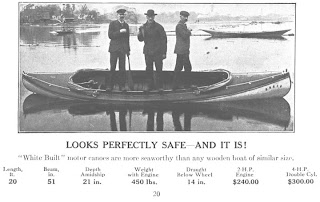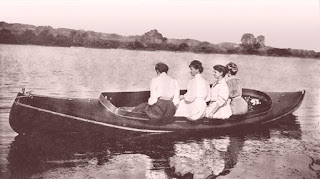I am presently working on a Northland V-stern canvas covered canoe, a model you don’t see that often. This is the first of their V-stern canoes for me, although I have restored many Northland canoes over the years.
 |
| Northland Canoe deck with decal. |
The company started out sometime in the mid 1940’s just
north of Huntsville. The present owner, Albert Maw, started with the company in
1956 as an employee and purchased the company in 1964. At one time the company
produced up to 200 canoes a year with a lineup of eight different models. A fire destroyed the company and its assets
in 1995. Northland Canoes is still in business, although today only as a one
man shop doing mostly repairs.
This Northland square-stern canoe was covered in a #10 canvas and filled with a polyester resin. A practise the company started in the 1960’s; later the canvas covering was replaced with fiberglass cloth on all their canoe models. A polyester resin was also brushed on the interior woodwork substituting varnish.
 |
| Removal of canvas glued to the hull. |
 |
| Sanding to make the hull smooth enough for the new canvas. |
The canvas was well
glued to the hull especially on its sides. So, I knew I was in for many hours
of unpleasant work with a heat gun and putty knife, followed by a lot of sanding
to make the hull exterior smooth enough for the new canvas covering.
The canoe was planked with white cedar, mostly flat sawn. As is common, with canoes planked with flat sawn planking there is a fair amount of buckled planking which need work, especially as the distance between planking tacks on this canoe was too great. I have replaced the planking with the worst buckling and cracking, in some areas re-nailing and adding extra tacks was sufficient to flatten out the buckled plank. When all tacks were well clinched and secure I carefully sanded the hull followed by an oiling of the hull exterior with a mixture of linseed oil and turpentine.
 |
| Stretching and stapling the canvas. |
 |
| View of v-stern with new canvas. |
The canoe’s owner wanted to watch and help out with the re-canvas work, so that morning I had two extra hands which finished the work on record time. On a v-stern like this the canvas is folded around the transom and fastened down in bedding compound. The stern is then covered by a fitted trim piece, in this case made from cherry.
 |
| Application of mildewcide to the canvas. |
Warmer weather and some sun the next day gave me the opportunity to move outside to apply a zinc-naphthenate mildewcide to the canvas covering. A smelly but absolutely necessary job if the canvas covering is going to last. Use of respirator and gloves is essential, and leaving the canoe outside to dry. You don’t want to breathe in the fumes from it. I apply the mildewcide with a foam brush and stop 4 or 5 inches short of reaching the sheer, the mildewcide will migrate down.
In the old times of lead based canvas
fillers this step wasn’t necessary as the lead in the filler was a very
effective mildewcide.
 |
| Zinc naphthenate preservative. |
A word of advice; If you are restoring or having your canoe restored don’t skip this step! Apply mildewcide to the canvas or purchase canvas which is pretreated with it. It is also a good idea to ad mildewcide to the filler, I do both. Without mildewcide treatment your canvas covering might not last more than a few years.




















